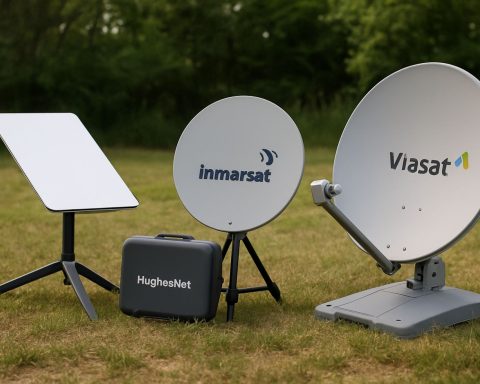- Nvidia and Broadcom are key players in the rapidly growing AI hardware market, each with unique strengths driving their success.
- Nvidia dominates the data center GPU market with a 92% share, bolstered by record-breaking sales of its Blackwell AI GPUs.
- Nvidia’s comprehensive ecosystem and strong supply chain positions it as a leader in aligning product development with AI demands.
- Broadcom excels with its custom ASICs tailored for AI tasks, resulting in AI revenue tripling to $12.2 billion in 2024.
- Broadcom’s partnerships with cloud customers offer lucrative growth prospects, with potential revenue up to $90 billion from AI chips.
- Both companies are at the forefront of the AI semiconductor market, providing investment opportunities as the market is expected to reach $360 billion by 2030.
- Savvy investors might consider both Nvidia and Broadcom as complementary assets in a diversified AI investment strategy.
The landscape of artificial intelligence is rapidly evolving, and two giants, Nvidia and Broadcom, find themselves at the heart of this revolution. As the demand for AI hardware surges, both companies have experienced remarkable growth over the past two years, driven by unprecedented innovation and strategic investments. Yet, despite this momentum, their stock prices have recently taken a hit, rattled by economic uncertainties like trade wars and recession fears.
For Nvidia, the journey has been akin to navigating a rapidly shifting maze where innovation lights the path. The company ignited the AI spark with its groundbreaking data center GPUs, playing a crucial role in the AI breakthroughs by pioneers like OpenAI. With a staggering 92% control of the data center GPU market in 2024, Nvidia’s influence is undeniable. Its latest offering, the Blackwell AI GPUs, has shattered sales records, pushing the company to new heights.
The astronomical demand for these processors, tailored for reasoning AI inferences, underscores Nvidia’s mastery in aligning product development with market needs. The journey hasn’t been easy, but Nvidia’s robust ecosystem—comprising a deep supply chain and a vibrant developer community—solidifies its pedestal in the AI chip market.
Meanwhile, Broadcom charts a distinct path in the AI sphere with its custom application-specific integrated circuits (ASICs). These processors are finely tuned to tackle specialized tasks, providing efficiency and power in handling AI workloads. Witnessing its AI revenue triple to $12.2 billion in 2024 spotlights its strategic prowess and capacity for growth.
Broadcom’s alliances with hyperscale cloud customers reveal an untapped growth reservoir. Its custom AI processors are in high demand, with potential annual revenue opportunities projected between $60 billion and $90 billion from existing and incoming clients. As these custom chips progress to production readiness, Broadcom’s future looks poised for exponential growth—potentially outpacing market expectations.
Investors find themselves at an intriguing juncture. While Nvidia dazzles with its omnipresent GPUs and ongoing triumphs, Broadcom’s ASIC leadership carves out a formidable niche. Both stalwarts stand at the forefront of AI’s burgeoning semiconductor market, making them compelling choices for forward-thinking investors.
These titans in the AI sector showcase different yet complementary capabilities. Savvy investors would do well to view Nvidia and Broadcom as not merely alternatives, but allies in a robust, diversified investment strategy that taps into the future of AI innovation—a market expected to soar to $360 billion by 2030.
In an era defined by rapid technological evolution and strategic agility, the real winner may not just be one of these companies, but rather the investors who dare to embrace both, and in doing so, harness the full spectrum of AI-driven opportunities.
AI Wars: Nvidia vs. Broadcom – Who Will Win the Race?
Deep Dive into Nvidia and Broadcom’s AI Strategy
The artificial intelligence (AI) revolution is reshaping the technology landscape, with key players like Nvidia and Broadcom leading the charge. As their growth trajectories captivate investors and tech enthusiasts alike, let’s delve deeper into the untold facets of these AI titans.
Market Dynamics and Innovations
Nvidia’s Domination in AI:
With a “monopoly” on the data center GPU market—holding approximately 92% market share—Nvidia remains a cornerstone of AI development. This dominance is fueled by the unprecedented success of its latest offering, the Blackwell AI GPUs, which are pivotal for AI inference tasks essential in machine learning models.
Broadcom’s ASIC Advantage:
In contrast, Broadcom focuses on application-specific integrated circuits (ASICs) that offer remarkable efficiency for specialized AI workloads. The company’s success is underscored by its AI revenue, which has tripled, reaching an impressive $12.2 billion in 2024. Their partnerships with major cloud providers open vast growth opportunities.
Pressing Questions Answered
How do Nvidia’s and Broadcom’s approaches differ?
Nvidia specializes in general-purpose GPUs that power a wide array of AI applications, making them versatile for different machine learning tasks. On the other hand, Broadcom’s ASICs are tailored for specific applications, offering improved performance and energy efficiency for targeted AI computations.
What are the key challenges faced by both companies?
While demand is high, both Nvidia and Broadcom must navigate economic uncertainties like trade wars and fluctuating market conditions. These factors can affect supply chains and alter investment landscapes, posing challenges amid rapidly increasing AI demands.
Can both companies coexist in the AI market?
Yes, because their strategies are complementary. Nvidia’s GPUs and Broadcom’s ASICs cater to different facets of the AI ecosystem, which means they can thrive side-by-side, serving diverse client needs. This convergence presents a strengthened portfolio for investors.
Emerging Trends and Predictions
Market Forecast:
The AI hardware market is expected to skyrocket to $360 billion by 2030, with Nvidia and Broadcom prominently positioned to capture significant shares. This growth is driven by accelerating AI adoption across sectors such as healthcare, autonomous vehicles, and the Internet of Things (IoT).
Industry Trends:
1. Diversification of AI Applications: Customers are seeking more specialized AI solutions, enhancing demand for Broadcom’s ASICs.
2. AI in Edge Computing: Nvidia’s edge computing solutions are becoming critical for industries needing real-time data processing.
Investor Considerations
Pros and Cons Overview:
– Nvidia:
– Pros: Robust market share, broad application spectrum, established developer ecosystem.
– Cons: High dependency on GPU technology, potential impact from economic and geopolitical factors.
– Broadcom:
– Pros: Strong in niche markets with ASICs, strong client partnerships.
– Cons: Appears more heavily reliant on large-scale cloud partnerships.
Conclusion and Recommendations
In conclusion, Nvidia and Broadcom both stand at pivotal crossroads in the AI landscape. Their distinctive yet complementary technologies provide diverse opportunities for investors eager to partake in the AI boom. Investors would benefit from diversifying their portfolio with both Nvidia and Broadcom stocks to capitalize on different aspects of AI development.
Quick Tips for Savvy Investors:
1. Diversification: Invest in both Nvidia and Broadcom to hedge risks and benefit from the entire AI ecosystem.
2. Stay Informed: Follow industry trends and economic indicators that can impact AI market dynamics.
3. Evaluate Partnerships: Pay attention to both companies’ alliances—particularly Broadcom’s collaborations with hyperscale cloud providers—for insights into future growth trajectories.
For more insights on technology and investments, visit nvidia.com and broadcom.com.









